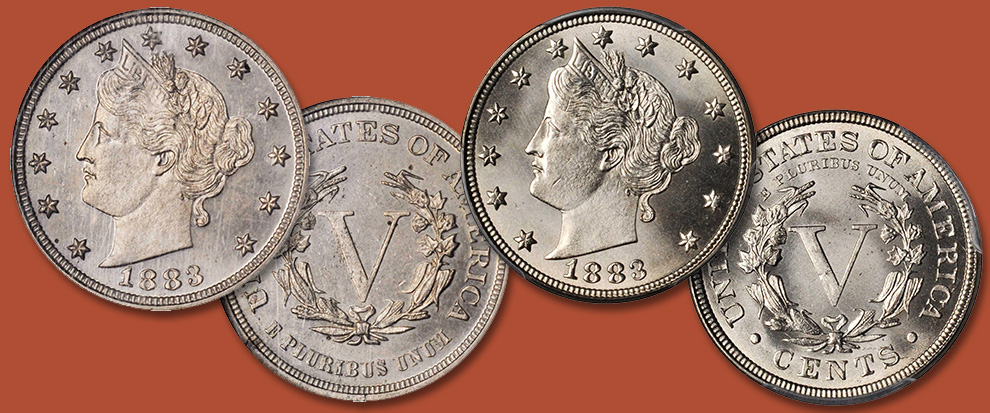
Looking for an affordable coin
with a generous measure of history?
In early 1883 there were perhaps
10,000 to 20,000 people who collected coins in a systematic manner. No more
than a couple thousand belonged to one or another of the societies. The American Journal of Numismatics was the magazine of record,
supplemented by newsletters and auction catalogs.
For two years Chief Engraver
Charles E. Barber had been experimenting with a new design to replace the
Shield-motif nickel in use since 1866. In 1881 and 1882 patterns with a Liberty
Head were made, the visage of the goddess Diana according to some. Early in
1883, after a production of Shield nickels, the new Liberty Head nickel made its
debut. The coin was beautiful. On the obverse Miss Liberty was surrounded with
13 stars with the date below. The reverse had a wreath, inscription around the
border and, at the center, the denomination given by the Roman numeral V, easy
enough to understand as meaning 5, as the current nickel three-cent piece,
having been made since 1865, was denominated in Roman numerals as III.
Similarly the silver trime of 1851 to 1873, of which millions continued to be
melted by the Treasury, was marked III.
Almost immediately after the new
nickels reached circulation, con artists realized that the diameter was about the same as that of
the $5 gold half eagle, which also had a Liberty Head, but of slightly
different appearance. The new nickels were given a plating of gold and, in some
instances, reeding was added to the edge in a machine shop. With their V
denomination they resembled a new design of the half eagle!
To avoid prosecution, the
typical passer of the new “half eagle” tendered it in payment of something worth
five cents, say a cigar. The shopkeeper or cashier, assuming it was a gold
coin, returned $4.95 in change. If confronted, the passer said that he had
given a regular nickel, gold plated, and it was the cashier who was at fault
for thinking it was worth so much. The Secret Service was alerted and soon
fielded several “operatives,” as agents were called, to arrest perpetrators
across the country, including an intensive search on the West Coast.
The Mint reacted quickly and
changed the reverse design by adding the word CENTS on the rim below the V.
Newspapers picked up on the story, stated that the Mint had made a mistake, and
that the Treasury was going to call in the CENTS-less nickels, after which they
would have great value. By that time 5,474,000 of the potential treasure
nickels were in circulation.
The nickel rush was on!
All across America men, women,
and children scrambled to gather as many of these rarities as could be found.
Nearly everyone was lucky. Some were able to squirrel away dozens. Interest
spread to other kinds of coins. Almost overnight the number of coin collectors
multiplied, probably to 50,000 or even more. This ushered in an era of
numismatic activity that saw dozens of people become dealers and the advent of
over a dozen new magazines featuring rare coins, usually in combination with
other collectibles such as stamps, fossils, autographs, and the like.
Coin auctions increased to a
frequency of about one per week. In the meantime nickels with the “corrected”
design were struck to the extent of 16,026,200, but attracted no interest at
all. As you read these words today in early 2020, 1883 nickels without CENTS
are very common in Mint State, and those with the word are dozens of times
rarer in the same condition!





